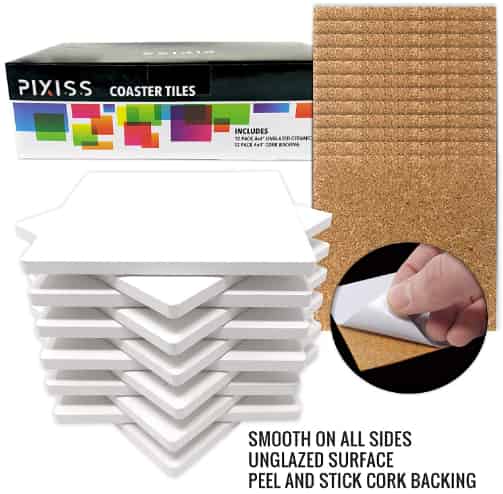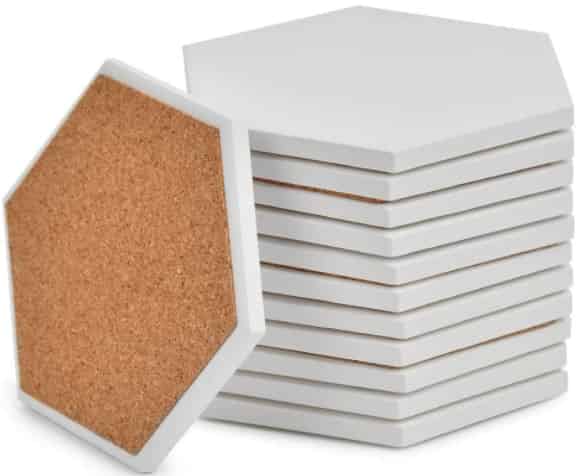
How thick is ceramic tile
To the naked eye, tile might look like something you purchase based on personal taste. But there is much more to tile than most recognize. There are various sizes, textures, and colors. The tile is durable and easy to look after, so people adore it withstands a good deal. Let’s know how thick is ceramic tile.
Before going purchasing ceramic tile, however, you ought to be aware of this flooring’s logistics. On the other hand, Ceramic tile will be shaped from white or red clays that contain other organic materials. Read more, how to seal ceramic tile?
What’s Ceramic?
Ceramic tile is a combination of clays and other all-natural materials. The distinctive clays are mined from the ground, shaped, colored as well as fired in kilns. Customary ceramic tiles may be colored and rendered unglazed like terra cotta.
Otherwise, they can feature colored or exceptionally designed surfaces that could be glazed (completed with a glass coating ) either at a high gloss or matte finish. Maximum ceramic tile comprises a white or reddish body coloration beneath the glistening, colored top layer. Check here, how long do ceramic coils last?
What’s ceramic consist of?
Ceramic consists of clay and other minerals, and it is fired in a kiln and medicated using a shiny color. Employing a beige color allows the tile to have a brighter and almost glass-like appearance. It means you’re getting the impression of glass without the accountability of the glass floor.
It is kiln-fired at a lower temperature than porcelain tiles, which is a lot more compact, porous, and thicker. If you exist in a warmer climate, you might prefer ceramic over porcelain due to its organic coolness. Also read, how to test a ceramic fuse?
The Importance of Ceramic Tile Thickness
Ceramic tiles are a versatile and popular choice for flooring and wall applications in homes and commercial spaces. When selecting ceramic tiles, one often overlooked yet critical factor to consider is the tile’s thickness. Tile thickness plays a vital role in various aspects, from installation to the visual appearance and long-term durability of the finished surface. In this article, we will delve into the significance of ceramic tile thickness and explore how it impacts different aspects of tile usage.
A. Define Tile Thickness and Its Role in Different Applications:
Tile thickness refers to the measurement of the tile from the bottom surface to the top surface. It is typically expressed in millimeters (mm) or inches (in). Ceramic tiles are available in various thicknesses, ranging from ultra-thin to thick. Each thickness serves a specific purpose and is suitable for different applications:
- Thin Tiles (Less than 5 mm):
- Thin tiles are often used for wall applications, such as backsplashes, shower walls, and decorative accents.
- They are lightweight and easy to install on vertical surfaces.
- Standard Thickness (6 mm to 10 mm):
- Standard thickness tiles are commonly used for both floor and wall applications.
- They strike a balance between weight and durability, making them versatile for various spaces.
- Thicker Tiles (12 mm and above):
- Thicker tiles are primarily used for heavy-duty applications, such as outdoor paving, high-traffic floors, and commercial spaces.
- Their increased thickness enhances durability and load-bearing capacity.
B. Discuss How Thicker Tiles Can Affect the Installation Process:
The thickness of ceramic tiles significantly influences the installation process:
- Substrate Preparation:
- Thicker tiles may require a more robust substrate preparation, including ensuring a level and stable base. This is particularly important for floor installations to prevent cracking or unevenness.
- Adhesive Selection:
- Different tile thicknesses may require specific adhesive types and application techniques. Thicker tiles often need a thicker adhesive bed to ensure proper bonding.
- Cutting and Shaping:
- Cutting and shaping thicker tiles can be more challenging and may require specialized tools and skills.
- Grouting:
- The grout lines between thicker tiles may need to be wider to accommodate the tile thickness variations, affecting the overall aesthetic.
C. Explain the Impact of Tile Thickness on Visual Appearance and Durability:
Tile thickness has a notable impact on both the visual appearance and durability of the installed surface:
- Visual Appearance:
- Thicker tiles often have a more substantial, premium look that can lend an upscale feel to a space.
- Thin tiles may appear delicate and are well-suited for creating intricate mosaic patterns.
- Durability:
- Thicker tiles are inherently more durable and less prone to chipping or cracking under heavy loads or impact.
- Thicker tiles are ideal for high-traffic areas and outdoor applications where durability is crucial.
Common Thicknesses of Ceramic Tiles
Ceramic tiles come in a variety of thicknesses to suit different applications and design preferences. Understanding the available options and selecting the appropriate thickness for your specific project is crucial for achieving both visual and functional success. In this article, we’ll explore the common thicknesses of ceramic tiles, their suitability for different areas, and any industry standards or guidelines to keep in mind.
A. Overview of Common Tile Thickness Options:
- Thin Tiles (Less than 5 mm):
- Often referred to as “thin-body” or “slim” tiles, these are the thinnest ceramic tiles available.
- Typically used for wall applications, such as backsplashes, shower walls, and decorative accents.
- Their lightweight nature makes them easy to handle and install on vertical surfaces.
- Standard Thickness (6 mm to 10 mm):
- This is the most common thickness range for ceramic tiles.
- Suitable for a wide range of applications, including both floors and walls.
- Strikes a balance between weight and durability, making it versatile for various spaces.
- Thicker Tiles (12 mm and above):
- Thicker tiles are used for heavy-duty applications, such as outdoor paving, high-traffic floors, and commercial spaces.
- Their increased thickness enhances durability and load-bearing capacity.
B. Appropriate Thickness for Different Areas:
- Floors:
- For residential interior floors, standard thickness tiles (6 mm to 10 mm) are commonly used. They offer durability and ease of maintenance.
- In high-traffic or commercial settings, thicker tiles (12 mm and above) may be preferable to withstand heavier loads and wear.
- Walls:
- Thin tiles (less than 5 mm) are ideal for wall applications. They are lightweight and suitable for vertical surfaces.
- Standard thickness tiles can also be used on walls, providing design versatility.
- Countertops:
- Countertops require tiles with greater thickness and strength. Thicker tiles (12 mm and above) or specialized countertop tiles are often used for this purpose.
- Outdoor Spaces:
- Thick tiles with a thickness of 12 mm or more are recommended for outdoor applications, such as patios and walkways, due to their ability to withstand weather conditions and heavy loads.
C. Industry Standards and Guidelines:
- Tile Council of North America (TCNA):
- The TCNA provides guidelines and standards for ceramic tile installation. They offer recommendations for tile thickness, substrate preparation, and installation methods.
- ISO Standards:
- ISO (International Organization for Standardization) has established international standards for ceramic tiles, including thickness specifications. These standards can provide valuable guidance for manufacturers and consumers.
- Manufacturer Recommendations:
- It’s essential to follow the manufacturer’s recommendations regarding tile thickness for specific products. Manufacturers often provide guidelines for where and how their tiles should be used.
In conclusion, ceramic tiles are available in various thicknesses to accommodate different applications. Selecting the appropriate tile thickness based on the area of use, aesthetic preferences, and industry standards is essential for achieving a successful and durable tile installation. By considering these factors, you can ensure that your ceramic tile project meets both functional and design requirements.
The Thickness of Ceramic Tile [How thick is ceramic tile]

If it comes to size, the depth of ceramic tile fluctuates. Floor tile is generally 1/2 inch to 3/4 inch thick and may be fabricated in 4 inches around 24 by 24 inches. Utmost ceramic tiles are 12 by 12 inches, but tiny tiles like a mosaic on the net can be as thin as 1/8 inch and move around 3/8 inch.
Ceramic can be implemented on the ground, wall, and shower so that you don’t need to think about the wall tile depth allowance and in which you can use it in contrast to tiles. Related article, best ceramic tile paint.
Shape construction
It is also possible to acquire different shapes like square foot, subway tile, octagonal and hexagonal. If you are using ceramic to the wall, it is likely to be much thinner and comes from squares from 3 inches to around 6 inches.
Mosaic tile is just two inches smaller and maybe set up piece by piece. Today, many people prefer mosaic tile since it is premounted on net sheets, so it is a lot easier to set up for the average DIYer.
Tile thickness varies on merchandise. Dimensions can be (3 to 11) millimeters in thickness. Ceramic wall tiles incline to be thinner in potage, while you will find ceramic tiles pressed in a 7-millimeter thickness with the same wear evaluations as a 10-millimeter product. You may like, best ceramic tile cutter.
Water absorption
Water absorption percent measures the hardness and density of the clay. It can be your very best tactic to find out the tile’s competence to withstand its structural power, thermal growth, its capacity to withstand consequences, along with the tile’s braking power.
The estimation is done by measuring the total amount of water that the tile will consume in a test utilizing a vacuum to saturate the inside of the tile. Tiles are considered before and after the evaluation. If the tile increases in weight by 4 percent, the absorption levels are equivalent to 4 percent. May you like, ceramic drill bit for tile.
Resistance
The resistance to breakage by effect is set by the MOHS scale, which goes out of 1 (chalk) to 10 ( diamond ). Many ceramic or reddish body tiles have been ranked at 7 to 9, the same detailed immunity as each other glassy ceramic on the marketplace.
Tile Thickness with Thinset

Thinset cement, thin-set mortar, dry-set mortar, and dry bound mortar are interchangeable together. This sort of cement adheres nicely in a thin coating. Tile thickness with thin-set varies. Typically, thinset is not put over 3/16 of an inch thick. I hope you already have knowledge about how thick is ceramic tile.
Porcelain vs. ceramic tile thickness
Porcelain tile comprises less than 0.5% water absorption, meaning it may be set up out in places where the temperatures move out of over 100 degrees in summer to below 32 degrees in winter.
The tiles won’t crack under the underlayment’s continuous expansion and contraction by absorbing virtually no moisture, whereas ceramic tile will.
However, in areas like Florida, where it’s uncommon to have freezing temperatures, this attribute becomes overkill. It’s possible to set up red body porcelain tiles with less than 6 percent of water absorption outside Florida and the many Southern States.
Advantages and Disadvantages
Ceramic is a more flexible and reasonably priced option should you want a great deal of tile. Additionally, it costs far less than ceramic and is much simpler to put in. Ceramic includes a softer coating, so homeowners may cut the tile using a very simple tile cutter.
It is a whole lot simpler because ceramic consists of a broader cutting procedure. If you are a lover of ceramic’s glossy appearance, you will be delighted to hear that the durable glossy finish could be customized in many different shades and patterns. Additionally, it has an attractive clean-lined look.
Disadvantages
One disadvantage of ceramic in comparison with ceramic is that ceramic is a little more lasting. Should you spill something, you have to clean this up quickly since ceramic has a higher absorption rate.
If you reside in a humidor moisture-ridden place, steer clear of adding ceramic into a shower or terrace. Since ceramic absorbs moisture, then you will want to do more regular deep cleans. Another disadvantage is the coolness that you receive from the tile in the warmer months might be brutal from the rainy months.
Additionally, the glaze may be attractive to some, but if you are accident-prone, tile may chip or crack. The chipped or cracked clay substance could show under, which means you need to be cautious with ceramic floors. To ensure that the tile stays in tiptop shape, use it in low to medium foot traffic areas. Furthermore, if you have younger kids, perhaps look at placing ceramics if they are older.
Which are ceramic tiles used for?
Ceramic tile could be the sole flooring material that works in almost any home. It is most often utilized in kitchens and baths in addition to foyers, mudrooms, along with other high-ranking places. But many houses, particularly in hot climates, utilize tile to good effect in living areas and bedrooms.
What are the downsides of ceramic tiles?
Ceramic floors are very hard. While this makes it a lot easier to clean and keep, in addition, it can make it embarrassing to stand. This substance, unlike resilient flooring, can not be softened with cushioned underlayments, so it may not be an appropriate selection for some.
That’s better ceramic or porcelain tile?
Called the most durable kind of tile available on the current market, ceramic is more complex, thicker, more challenging, and less porous than ceramic tile. Additionally, it has a very low absorption rate, which means it is almost impervious to water damage, even after prolonged exposure.
FAQ’s
Certainly! Here are some frequently asked questions (FAQs) about the thickness of ceramic tiles:
How thick is a standard ceramic floor tile?
Standard ceramic floor tiles are typically 1/4 inch (6.35 mm) thick.
What is the thickness of ceramic wall tiles?
Ceramic wall tiles are usually thinner than floor tiles, commonly measuring 1/8 inch (3.175 mm) thick.
Are there variations in the thickness of ceramic tiles?
Yes, ceramic tiles come in various thicknesses, depending on their intended use. There are also thicker porcelain tiles available, which are a type of ceramic tile.
Can I find thicker ceramic tiles for specific purposes?
Yes, you can find thicker ceramic tiles designed for heavy-duty applications such as outdoor use or commercial settings. These can range from 3/8 inch (9.525 mm) to 3/4 inch (19.05 mm) in thickness.
Are subway tiles typically thicker than other wall tiles?
Subway tiles, a popular type of ceramic wall tile, are usually 1/8 to 3/16 inch (3.175 to 4.7625 mm) thick, similar to other wall tiles.
What is the advantage of thicker ceramic tiles?
Thicker ceramic tiles are generally more durable and suitable for high-traffic areas. They can withstand heavier loads and are less prone to chipping or cracking.
Are there any disadvantages to using thicker ceramic tiles?
Thicker tiles can be heavier, making them more challenging to install. They may also require additional adhesive or mortar to secure them properly.
What is the thickness of mosaic ceramic tiles?
Mosaic ceramic tiles come in various thicknesses, but they are often around 1/8 inch (3.175 mm) thick. Some variations may be thicker or thinner depending on the design.
Do ceramic tile thicknesses vary by region or country?
While there are standard thicknesses for ceramic tiles, there may be some regional variations or preferences in certain countries or areas.
Can I use different thicknesses of ceramic tiles in the same project?
It’s not recommended to mix tiles of significantly different thicknesses in the same project, as it can create uneven surfaces and installation challenges. Stick to a consistent thickness for a uniform look.
How can I measure the thickness of a ceramic tile?
You can measure the thickness of a ceramic tile using a caliper or a ruler. Place the measuring tool perpendicular to the tile’s surface to get an accurate measurement.
Are ceramic tiles the same thickness as porcelain tiles?
Porcelain tiles are a type of ceramic tile, and they can have similar thicknesses, depending on their intended use. Porcelain tiles are often denser and less porous than standard ceramic tiles, but they come in various thicknesses.
Are there any specific requirements for tile thickness in building codes or regulations?
Building codes and regulations may specify minimum thickness requirements for tiles in certain applications, such as flooring in commercial buildings or outdoor use. It’s essential to check local codes and guidelines when planning your tile installation.
Conclusion
In conclusion, the thickness of ceramic tiles can vary depending on their intended use and design, but there are some standard measurements to keep in mind. Standard ceramic floor tiles are typically 1/4 inch (6.35 mm) thick, while ceramic wall tiles are usually thinner, around 1/8 inch (3.175 mm). Thicker ceramic tiles are available for heavy-duty applications and can range from 3/8 inch (9.525 mm) to 3/4 inch (19.05 mm) thick.
The choice of tile thickness depends on factors such as the type of project, the intended location of the tiles, and design preferences. Thicker tiles are generally more durable but may require additional adhesive and can be heavier to handle during installation.
It’s essential to follow manufacturer recommendations and consider local building codes and regulations when selecting the appropriate tile thickness for your project. Ultimately, understanding the thickness of ceramic tiles is crucial for ensuring a successful and long-lasting tile installation.